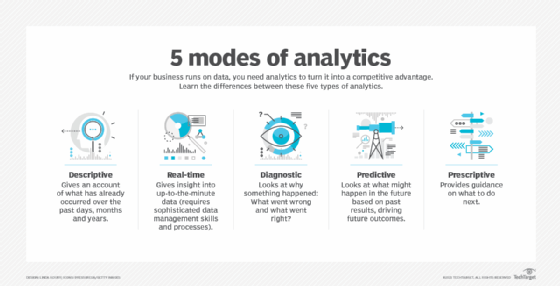What is prescriptive analytics?
Prescriptive analytics is a type of data analytics that provides guidance on what should happen next. It's related to descriptive, diagnostic and predictive analytics. Descriptive analytics aims to provide insight into what has happened; diagnostic analytics identifies why it happened; and predictive analytics helps model and forecast what might happen. Given the known parameters, prescriptive analytics helps users determine the best option or outcome among various possibilities.
At a high level, prescriptive analytics operationalizes insights from the other types of analytics through business tools, such as recommendation engines, dynamic pricing models, loan approval engines and machine repair scheduling. It is the cornerstone of business rules management systems.
Business users might be unaware they are using prescriptive analytics capabilities since they are likely more concerned about the outcome than the specific analytics technique. The field of prescriptive analytics is growing in popularity, as its core techniques have become part of data science and machine learning (ML) workflows.
How does prescriptive analytics work?
Prescriptive analytics encompasses a continuum of capabilities. It could be as simple as making a yes or no decision, suggesting inventory levels, adjusting prices or automating stock trades based on market conditions.
In more complex scenarios, prescriptive analytics can also suggest decision options for taking advantage of a future opportunity or mitigating a future risk and illustrate the implications of each decision option. One goal in developing predictive analytics is to continually and automatically process new data to improve the accuracy of predictions and provide better decision options.
It is common for organizations implementing prescriptive analytics to have already explored descriptive analytics and predictive analytics. Past performance and anticipated trends are essential in deriving actionable insights to inform organizational strategy. Predictive analytics will surface selectable features that are optimal for predictive power and usefulness in model design.
The most sophisticated prescriptive analytics models are enabled by stream processing engines, analyzing potential decisions, the interactions between decisions, the influences that bear upon these decisions and the effect of all the above on an outcome to ultimately prescribe an optimal course of action in real time.
Teams develop prescriptive analytics applications using standard data science development processes and tools, including data mining, ML and deep learning. This starts with specifying requirements, identifying relevant data sources, organizing the data, developing the model and deploying it into production.
Deploying the model into production is one of the most challenging steps and is one area in which prescriptive analytics differs from other types of analytics. The prescriptive analytics engine often directly makes a decision, rather than presenting an analysis or prediction, so the stakes might be higher if the decision is wrong. Prescriptive analytics operationalizes decisions, introducing more stringent latency requirements on data processing.
Prescriptive analytics takes advantage of structured, unstructured or mixed data. Data engineers and data scientists, either at an enterprise or working for vendors to develop prescriptive analytics products, must consider the best types of data and the most appropriate way of structuring it. For example, a product recommendation engine might ingest all customer transactions into a graph database to identify products purchased by similar customers. Similarly, data-driven decisions at the C-level might seek to determine actionable insights, future trends and future outcomes to make informed decisions based on prescriptive options derived from historical data on industry disruptions.

What are the benefits and challenges of prescriptive analytics?
Prescriptive analytics is not fail-proof. It is subject to the same distortions that can upend descriptive analytics and predictive analytics, including data limitations and unaccounted-for external forces. The effectiveness of prescriptive analytics also depends on how well the decision model captures the effect of the analyzed decisions. The following are some of the benefits and challenges of prescriptive analytics.
Benefits of prescriptive analytics
- Provides high-quality, data-driven decisions. Actionable insights derived from prescriptive processes can surface strategic options at a highly granular level.
- Speeds complex approval processes. Automated decision-making enables faster time to value.
- Enables faster response to changing market conditions. Automating stock trades faster than humans can, for example, reduces manual work and bolsters efficiency.
- Improves resilience to fast-changing circumstances. Recommending specific actions can help enterprises better ride out supply chain disruptions, for example.
- Enhances customer experience (CX). The ability to score individual transactions helps prescriptive analytics identify optimal CX improvements.
- Minimizes risk. Prescriptive analytics can detect fraud by scoring individual transactions, singling out the most problematic.
- Operationalizes predictive analytics insights. This increases the value of existing analytics.
Challenges of prescriptive analytics
- Escalates bad decisions. Prescriptive analytics accelerates the effect of bad decisions. One example of this is a stock market crash resulting from automated trading.
- Not all applications are feasible. Because of the stringent data engineering requirements of prescriptive analytics, some applications might not be feasible for using this type of analytics. For example, a checkout app using prescriptive analytics might make customers wait too long.
- Susceptible to bias. Bias can be accidentally or intentionally baked into analytics models and is perpetuated by automation.
- Increases risk of noncompliance. Explainability, or the ability to explain how the model works, can be elusive in prescriptive analytics models, putting companies at risk of noncompliance with regulations such as the General Data Protection Regulation.
- Bad inputs can yield bad prescriptions. The old "garbage in, garbage out" adage applies, as bad inputs yield bad prescriptions. If the data fed into prescriptive models is flawed, the recommendations generated will also be flawed.
- Expensive to implement and maintain. Prescriptive models require performance infrastructure and processes for ongoing monitoring and adjustment.
- Models must be monitored for unintended consequences. For example, a prescriptive analytics algorithm in a social media algorithm might promote shared content more widely. Viral content is sometimes driven by hate, so developers must consider ways to mitigate this unintended consequence.
Examples and uses of prescriptive analytics
Prescriptive analytics is the most sophisticated of the various types of data analytics and requires mature data processes to implement.
Prescriptive analytics must be adaptive to accommodate changes in the economy, environment and business dynamics. Some of the scientific disciplines associated with prescriptive analytics include ML, natural language processing (NLP) and one or more of the other types of analytics.
For example, customer lifetime value uses descriptive analytics to calculate a value for each customer. The analytics enables companies to find other high-value customers based on their similarity to existing high-value customers.
Through various iterative modeling approaches, marketers and retailers can then use predictive analytics to predict when customers will purchase again or the time until purchase. Prescriptive analytics then provides the decisions and affect needed to influence a customer's path and time to purchase.
The following are examples of prescriptive analytics uses in various vertical markets:
- Healthcare. Analyzing historical resource consumption reports enables a hospital to plan optimal staff scheduling and better anticipate patient flow.
- Manufacturing. A maintenance scheduling engine optimizes machine repair in response to a predictive maintenance engine that estimates the cost of downtime, cost of failure, production loads, technician availability and maintenance status of other machines.
- Transportation and supply chain. A ride-sharing company introduces surge pricing to incentivize more drivers to act during peak demand, and a shipping company analyzes traffic patterns and conditions to update its fleet's routing in real time.
- Banking. A loan approval engine automates the approval process based on income, credit score and profession; a fraud management application decides whether to approve a transaction based on its history, location, amount and type.
- Sales and marketing. A product recommendation engine suggests other products based on prior purchase history and the purchases of similar customers.
- Security. An AI-powered security management application looks for abnormal activity and blocks suspicious transactions.
Prescriptive vs. predictive analytics
Prescriptive analytics and predictive analytics have much in common at first glance. They are both about generating actionable insights and enabling more informed decisions, and both surface future outcomes. But they differ in the following ways:
- Results. Predictive analytics answers the question, "What is going to happen?" Prescriptive analytics answers the question, "What should we do about it?"
- The role of people in the process. Predictive analytics informs human decision-making, free of any specific guidance; prescriptive analytics removes people from the process, likewise removing human bias.
- Inputs. Predictive analytics are typically built around predetermined scenarios; prescriptive analytics are broader, using inputs that incorporate the organization's operational dynamics.
Prescriptive analytics tools
Advancements in the speed of computing and the development of complex mathematical algorithms applied to the data sets have made prescriptive analysis possible. Specific techniques used in prescriptive analytics include optimization, simulation, game theory and decision-analysis methods.
Data science and ML tools form the foundation of a prescriptive analytics practice. These tools can help automate the process of creating the models required for prescriptive analytics. Enterprises can extend these capabilities to a broader base of users using new tools specifically designed for citizen analytics.
Data management and data processing can also improve prescriptive analytics at scale. Stream processing and stream analytics applications simplify data engineering tasks for ingesting data to support a particular recommendation or decision. Graph databases, data fabrics and data schema tools can simplify the data science task for mapping existing data to new use cases.
Business process tools can help operationalize prescriptive analytics insights. Business rules management systems can provide the underlying frameworks for connecting multiple prescriptive models. Intelligent process automation tools can connect the dots between automated decisions and robotic process automation tools.
The following is a sampling of vendor-provided prescriptive analytics options:
- Altair AI Studio.
- Altair RapidMiner.
- Alteryx One Platform.
- IBM Decision Optimization.
- SAS Decision Manager.
- Tableau.
The future of prescriptive analytics
The future of prescriptive analytics will be driven by the explosion in big data, new modeling approaches and better AI techniques. Hurdles to adoption will include new regulations and pushback regarding privacy. Risks associated with bias, discrimination and unintended consequences will also affect prescriptive analytics applications.
The rise in big data opens the potential to mine a far more extensive range and type of data to improve decision-making. For example, some firms are using data from social media and other third-party sources to consider loan approval for people lacking traditional credit scores. Enterprise data catalogs and new data wrangling techniques make it easier to discover and operationalize new patterns at scale.
Sustainability concerns are driving collaboration on taxonomies and best practices for measuring business decisions' environmental, social and governance impact. Vendors are starting to offer services to measure the supply chain's carbon footprint, relate satellite imagery to business decisions, and detect data leaks and privacy violations.
New modeling approaches enable teams to make more accurate decisions. For example, physics engines can improve predictive and prescriptive maintenance by enhancing AI models. Digital twins can help strengthen the context of complex decisions across multiple stakeholders. Improvements in AI NLP techniques can connect the dots between news reports and their likely effect on business operations.
Despite the difficulty and expense of implementing and maintaining prescriptive analytics systems, it is rapidly becoming mission-critical across industries for organizations dependent on sustaining a competitive edge, ensuring that its uptake will continue to increase despite the challenges.
Although digital twin technology offers manufacturing operations many benefits, it also has some drawbacks. Learn how organizations can implement this technology while avoiding the pitfalls.







